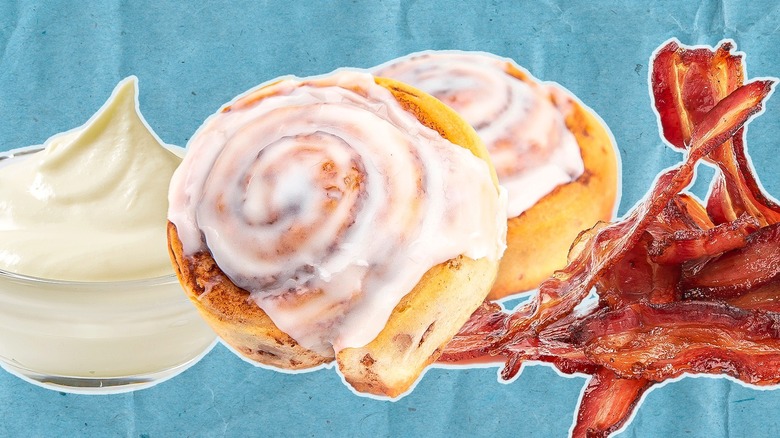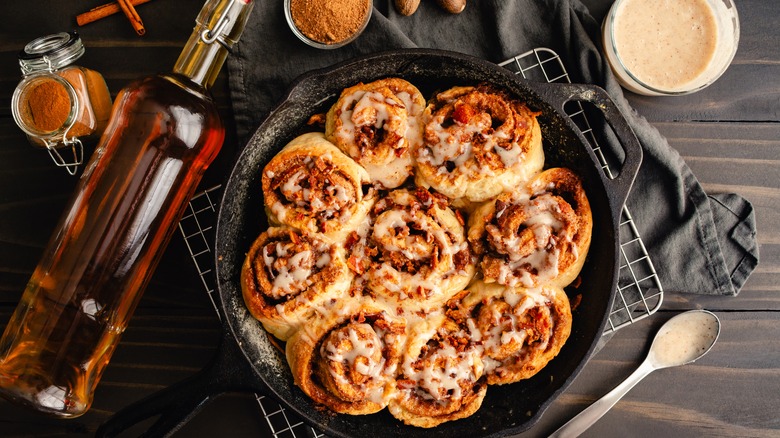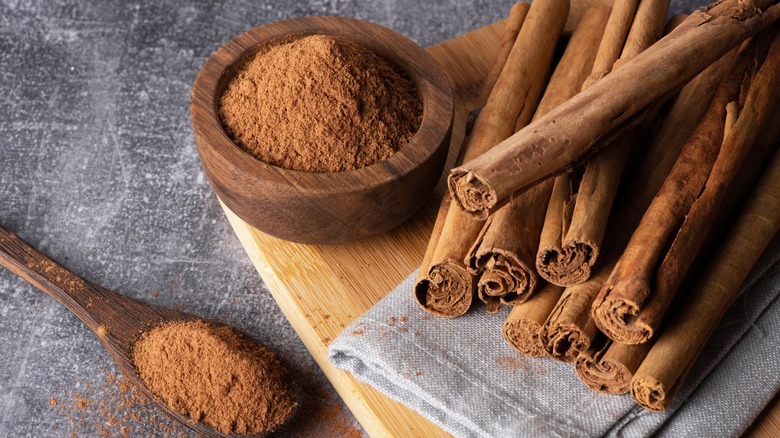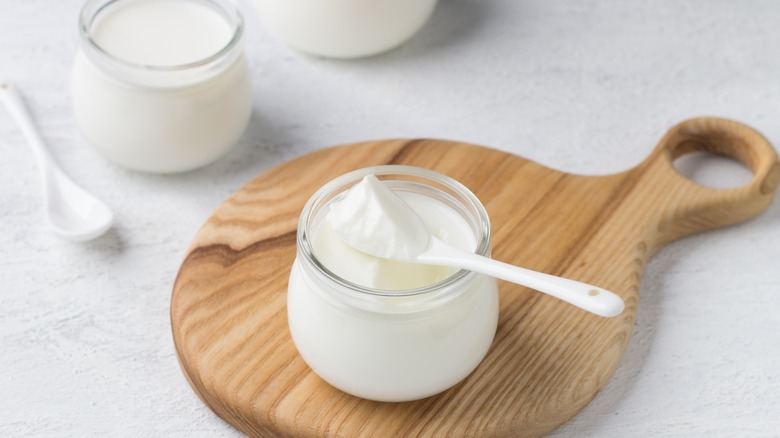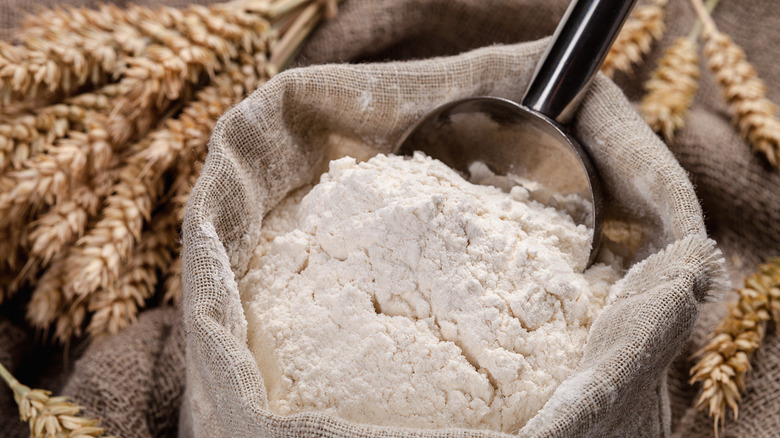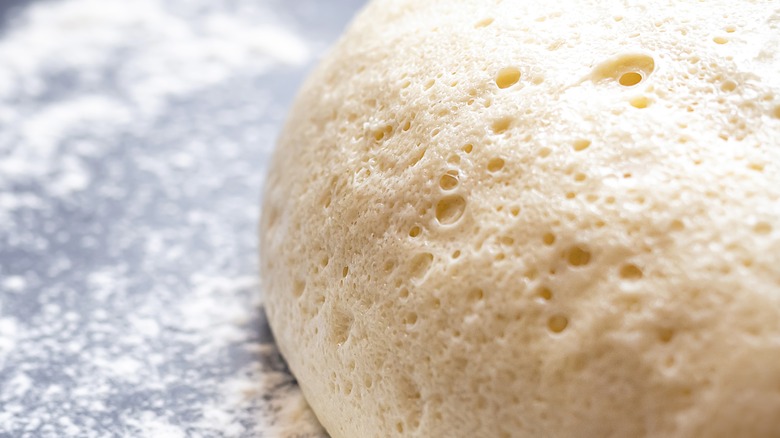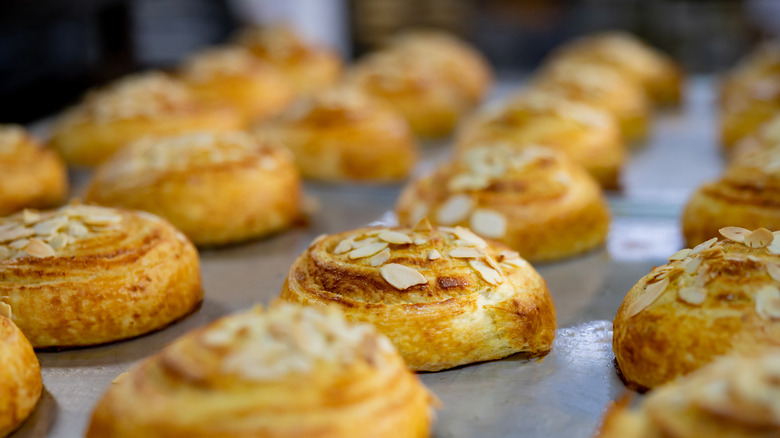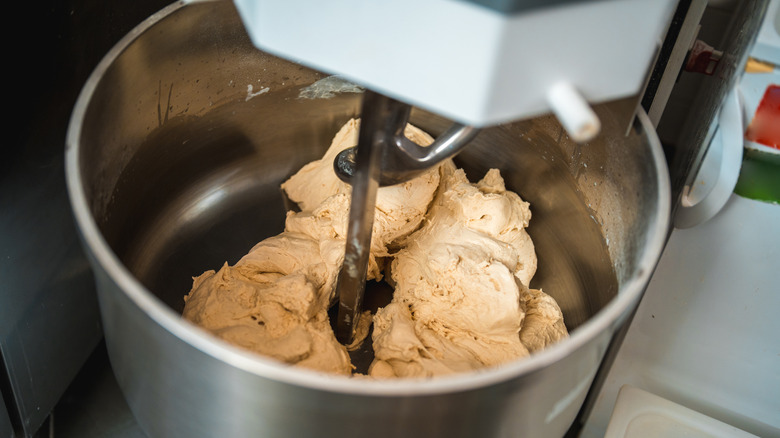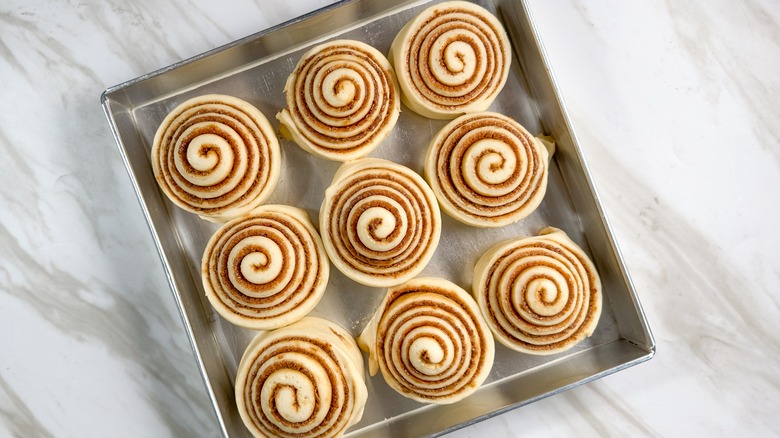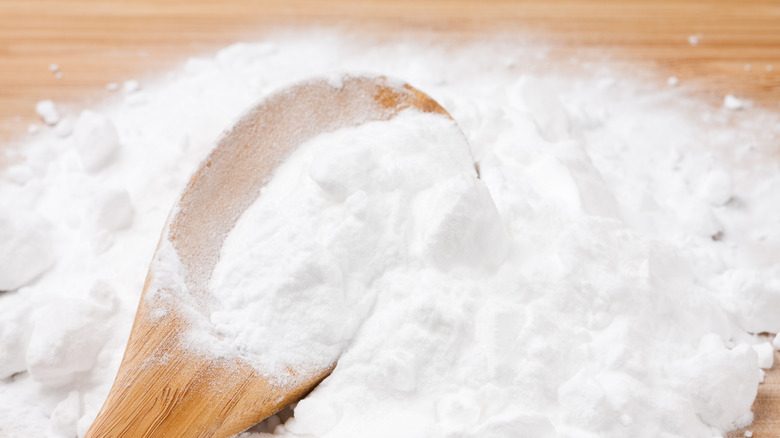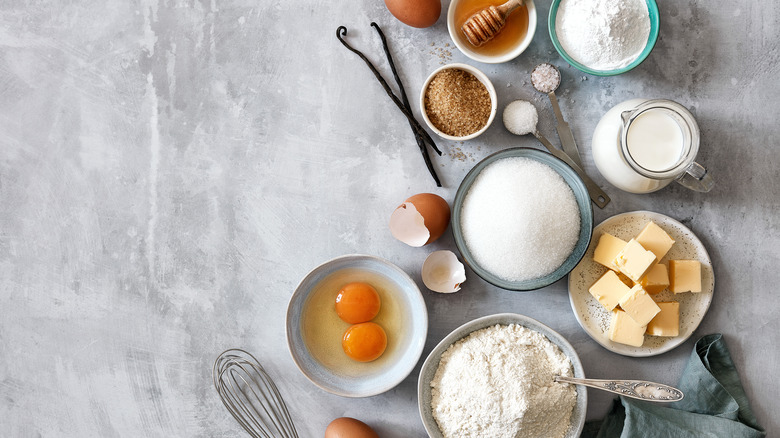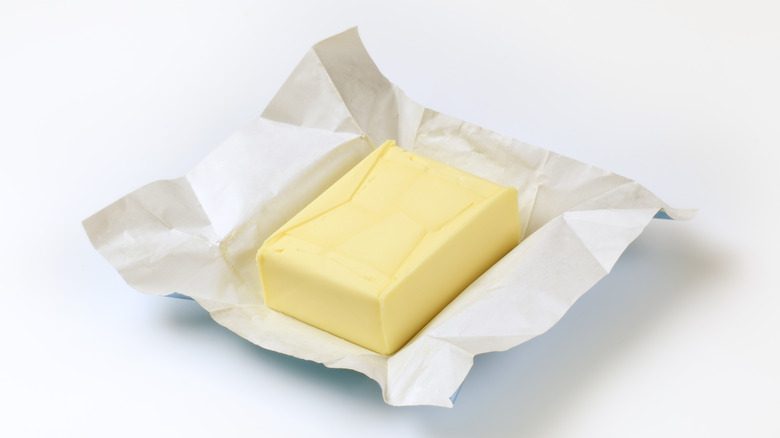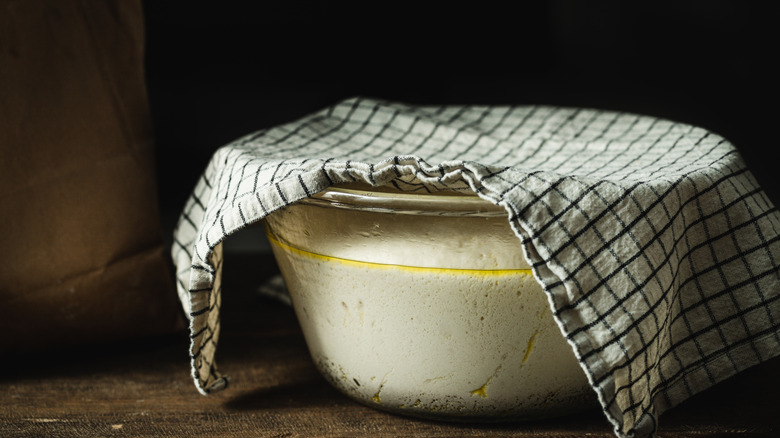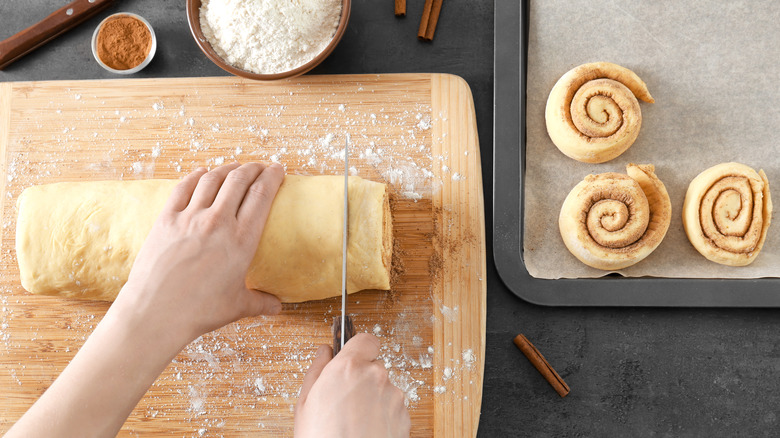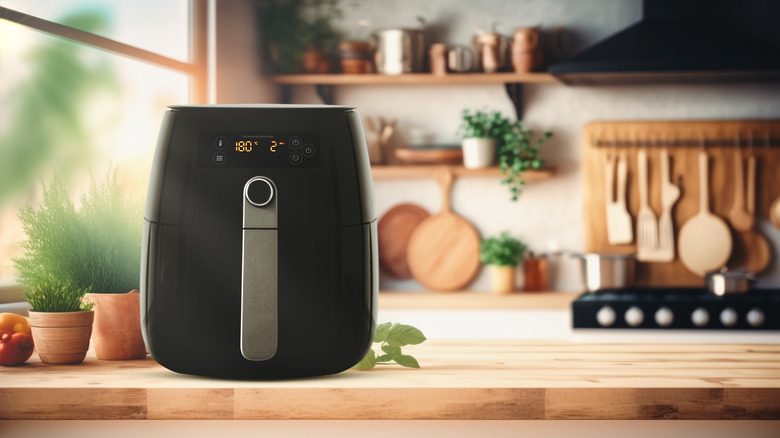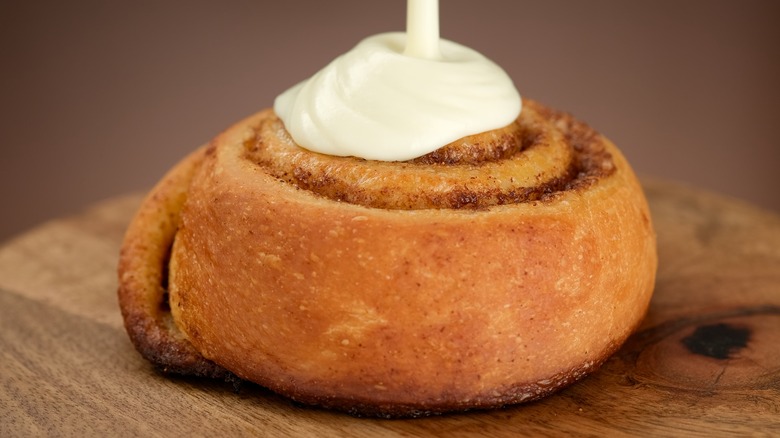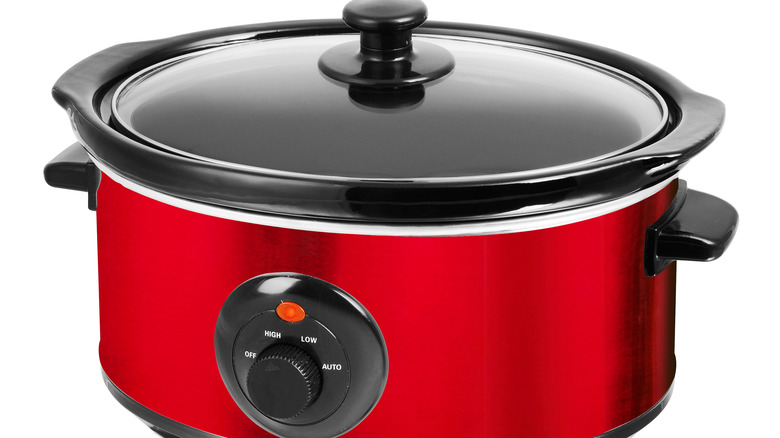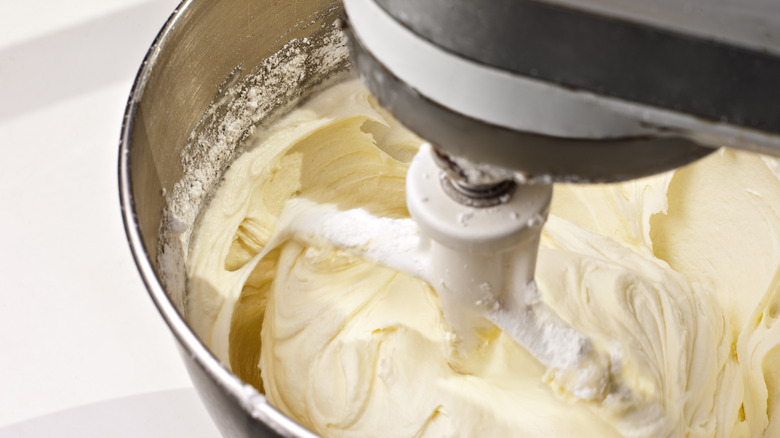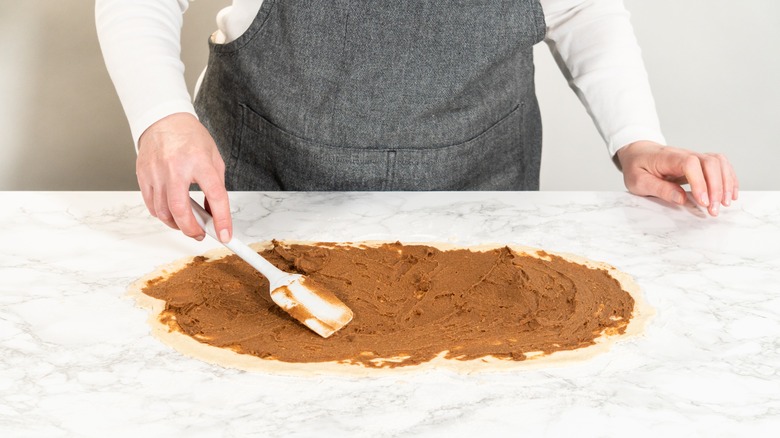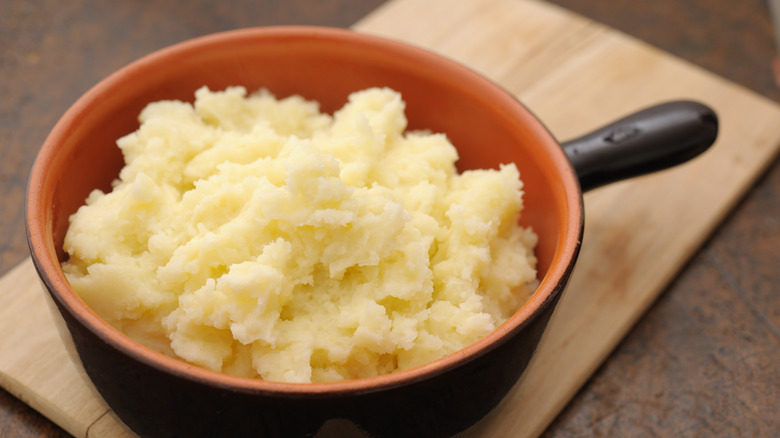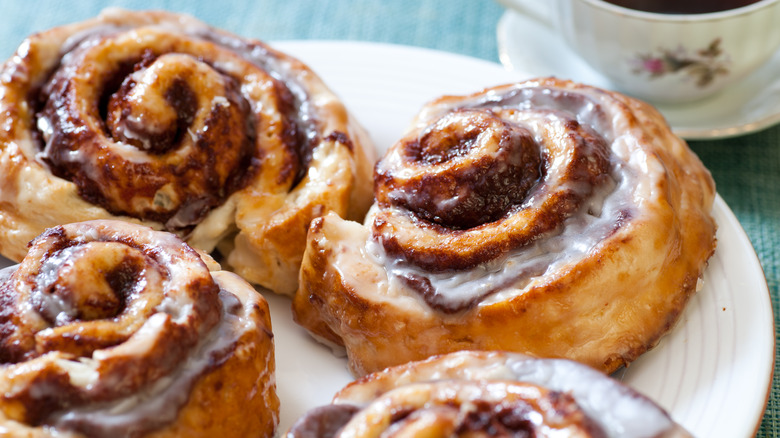20 Tips For The Best Homemade Cinnamon Rolls
There's no feeling quite like waking up to a warm batch of cinnamon rolls. Not only is it the smell of brown sugar and cinnamon wafting from your kitchen, but also the feeling of sticky, icing-coated fingers ripping apart the carefully rolled layers of enriched dough, encasing a sweet surprise inside. While eating these breakfast treats may be nothing short of magical, the feeling of making these rolls doesn't make us feel the same way.
The fact of the matter is that making cinnamon rolls is a pain in the neck. Since the dough contains yeast, bakers have to be very, very intentional with the temperature, quality, and amount of their ingredients to ensure the dough gets the proper rise. Let alone the fact that a batch of cinnamon rolls takes over two hours to make. We've made many, many batches of cinnamon rolls and seen the good, the bad, and the downright ugly results of our mistakes. So, we're on a mission to hack cinnamon rolls to make them easier, fluffier, and better-tasting than the ones from the Pillsbury can. Here are some of our best pieces of advice for your next batch of homemade cinnamon rolls.
Incorporate bacon for a savory twist
Crafting the perfect dessert (err... breakfast) is all about playing with the complimentary sweet and savory flavors. One of the easiest contrasts to add to your recipe is with leftover bacon. It will give your cinnamon rolls a delicious twist and allow you to use up the leftover breakfast meat in one shot.
You'll want to start with your bacon cooked until crispy before sprinkling it on the dough before baking it. You can use brown sugar or maple glaze bacon for this recipe. We also recommend going a step beyond the conventional recipe by making a maple cream cheese glaze for your rolls to contrast the saltiness of the bacon. It's a wholesome breakfast idea that will also give you a hefty dose of protein to start your day the right way.
Explore different types of cinnamon
Upgrading your homemade cinnamon roll recipe is all about rethinking the ingredients you've been using for years. One of the simplest swaps you can make in your recipe is using a different type of cinnamon than what's in your pantry. Most grocery store cinnamon is Cassia, which has a spicy undertone and a mild, relatively boring flavor. Ceylon cinnamon, on the other hand, has a sweet and floral aroma that makes it perfect for adding to your sweet recipes — like cinnamon rolls.
Cinnamon isn't the only spice you can add to your rolls to alter the flavor. We also love adding fresh ground cardamom to our cinnamon buns for a bright, spicy flavor that will make your buns a bit more mature and complex.
Use Greek yogurt to add extra moisture to your rolls
One of the pitfalls with cinnamon rolls is that they can come out dry. This can be a symptom of many problems, including a lack of moisture in the dough and not giving them enough time to rest. The easiest way to alleviate these cinnamon roll woes and to knock a few hours off of your recipe time is to use Greek yogurt instead of yeast. The Greek yogurt contains a healthy dose of fat and protein that keeps the dough soft and spongy while enhancing the roll's flavors.
You don't only have to add the Greek yogurt to the dough; you can also substitute it for other ingredients in the frosting. It will have a tang similar to cream cheese, with fewer calories and the same richness.
Bread flour makes for a better structure
The type of flour you use for your recipe is very important to the structure of your cinnamon roll. It's important to remember that cinnamon rolls are bread — a rich one at that — and need to be treated as such. Therefore, bread flour, which has a higher gluten content, is ideal for making cinnamon rolls that have a springy texture and bread-like bite.
The key to making perfect cinnamon rolls is to use the tangzhong method. This technique is derived from Asia and requires a baker to combine and cook high-gluten flour (which absorbs liquid better than all-purpose) with water or milk until a thick, roux-like paste is formed. Scientifically speaking, cooking the ingredients gelatinizes the starches, which increases its potential to hold water and keeps it pliable. Bread dough made with the tangzhong method tends to remain soft even days after you bake it.
Always use fresh yeast for your recipe
You'd be surprised by the role that fresh yeast plays in getting the perfect consistency for any bread recipe. Fresh, active yeast is able to digest the sugars in the flour and dough and produce copious amounts of carbon dioxide that allows your dough to puff up and rise. If your yeast is on the brink of being thrown away, you won't get nearly the right rise needed to get bakery-level cinnamon rolls.
The key to working with yeast is to always test it before tossing it into the dough. You should always store your opened containers of yeast in the fridge for up to four months. Swirl the yeast in a glass of warm water with granulated sugar to test it. You're looking for a yeasty aroma and bubbling effect.
Space your rolls out in the pan to prevent them from coming out
How do you decide how close or compact to place your rolls on the baking sheet? They're not like cookies where they spread as they bake, but placing them far apart will yield the best consistency in your finished recipe. When the cinnamon rolls are packed like sardines in a cast iron skillet, the rolls only have room to grow upwards rather than outwards. This mistake lends itself to doughy cinnamon rolls or ones that have centers that pop out more than the rest of the roll.
If you like stand-alone cinnamon rolls, like the ones found in a bakery, place them at least two inches apart on a baking sheet. For pull-apart rolls, give them about an inch apart on all sides.
Hit the mixing sweet spot for a good, strong dough
It's difficult to determine how much to mix your dough. The physical manipulation of the dough, either by a stand mixer or your hands, helps develop the gluten proteins that trap the air bubbles inside. If you fail to work your dough enough, then your rolls will come out deflated and stodgy. But if you overwork the dough, it will be hard to roll out on the baking sheet and will come out dense rather than elasticky.
The trick to getting the perfect cinnamon roll dough is adding your flour incrementally and mixing it until the surface is smooth and starts pulling away from the bowl's outside. You should also note the texture of your dough; sticky dough still needs more time before it's ready to proof.
Don't cut the proofing time short
Cinnamon rolls take a long time. If you're in a rush to get your rolls in the oven, you might be inclined to cut your proofing time short. After all, what's another 20 minutes?
The cinnamon roll needs to be proofed twice. The first time occurs after the ingredients have been mixed together; you should cover the dough with a towel and let it rest until it has doubled in size before giving it a quick punch down. The second time occurs after your homemade cinnamon rolls have been filled and shaped. This last puff gives the "oven-spring" and rounds out the flavors on your dough before you put it in the oven. Don't cut the proofing time short; note you may have to allocate more time if your kitchen is cooler or at a different altitude.
Use baking soda to help your cinnamon rolls brown
Getting the perfect golden-brown to light-brown color on your rolls is tough, but baking soda is coming to the rescue. It's the extra ingredient that will help your cinnamon rolls brown because the alkaline powder will balance out the pH in the dough, which helps promote the Maillard reaction in the dough. The Malliard reaction is the primary factor that promotes a caramel flavor and dark color, so any boost will help yield better rolls.
In addition, the alkaline nature of the product will help moderate the amount of gluten in the dough and cause it to become less chewy and more soft, which results in a better bite. Besides adding baking soda, you should also be sure to keep the rolls in the oven for the entire duration of the baking time until the center of the roll reads 190 F.
Be mindful of the temperature of your ingredients
When you're baking anything, you should always pay attention to the temperature of your ingredients. Otherwise, you might alter the texture and color of the rolls or cause a problematic chain reaction that alters your recipe entirely. One of these tricky bends is with your milk. For tender, fluffy cinnamon rolls, you should always use milk that is heated just right. Adding scalding milk to your dough may kill off the yeast responsible for giving it its rise, thus rendering it dense.
The sweet spot for heating the milk is between 100 F and 115 F. It will activate the yeast and allow it to feast on the sugars in your dough, thus speeding up the rise time. Room-temperature eggs are also ideal for your recipe because they will mix better with the other ingredients.
Stick to softened butter for the filling
The trick to getting the perfect consistency for your cinnamon roll filling is always to use softened butter rather than melted. Melted butter should never be used in cinnamon roll filling because it splatters all over the dough. Softened butter is easier to spread on the inside of the dough, creating a thick layer of filling on your dough. Luckily, you can leave the butter on your counter before you start baking to ensure it is soft by the time you start baking with it.
Besides using softened butter, which should spread easily with a rubber spatula, you should also avoid overfilling your cinnamon rolls. This will lead to the filling spilling out everywhere and sticking to every surface in sight. In addition, always leave an inch of buffer on the outside of your rolls for mess-free rolling.
Refrigerate your dough before rolling it out
Refrigerating dough is the secret to excellent cookies, but it's also a useful technique to utilize for your cinnamon rolls. Refrigerating the dough is the Pioneer Woman's secret method for the perfect cinnamon rolls. Per Ree Drummond, popping the dough in the refrigerator before rolling and baking is vital to developing a better flavor. The cool temperature slows down the yeast from metabolizing and releasing the carbon dioxide, which concentrates the flavors in the dough.
In addition, the cool temperatures will make it easier to slice the dough. If you put the dough in the fridge, you're going to want to make sure you seal it completely with plastic wrap to prevent the water from drying off the surface of the dough.
Use dental floss to slice perfectly even cinnamon rolls
Let's face it: Uniformity is not everyone's baking strong suit. But with a little help from baking floss, slicing cinnamon rolls evenly could never be easier. The simple dental floss trick involves running the unflavored floss along the bottom of the log and pulling the string in opposite directions. This will slice through the dough easier than using a knife and reduce the amount of dishes you'll have to do, too.
Besides slicing the dough with string, you can also ensure your rolls are neat and tidy by tucking the ends underneath to prevent the roll from rolling out on the sheet. You can also take a ruler to your rolls to ensure that the rolls are evenly sized before you pull your floss out.
Try cooking your cinnamon rolls in the air fryer instead of the oven
The oven isn't always the best place to bake your cinnamon rolls. Instead of popping the tray into the oven, try making your next batch of cinnamon rolls in everyone's favorite kitchen appliance: the air fryer. Set your air fryer to 350 F and bake your rolls until golden brown and crispy.
This texture will take much less time than baking your rolls in a conventional oven, and it's perfect for baking your rolls when you don't want to heat up your whole house just by running the oven. The best thing about this recipe is that it bakes faster than a conventional oven, and you can use it for store-bought cinnamon roll dough or a homemade recipe.
Heavy cream makes for the viral TikTok cinnamon rolls
Have you heard about the TikTok cinnamon roll hack? It involves pouring heavy cream on the top of the rolls before baking, which causes the dough to soak up the cream, become pillowy, and reminiscent of the Cinnabon rolls you'd find at your neighborhood mall. While the original TikTok hack recommends using store-bought cinnamon rolls for this recipe, the hack works just as well for homemade rolls, too.
Once your rolls are in the rimmed bacon pan, cover the rolls with the heavy whipping cream and an extra layer of brown sugar and melted butter. Then, bake the rolls as directed in the recipe and enjoy your soft, spongy, and decadent recipe topped with an extra scoop of icing.
Try making your next batch of rolls in the slow cooker
If you're baking your cinnamon rolls for a crowd, you might try to make them in a slow cooker instead of your oven. This appliance will make super tasty homemade cinnamon rolls because it steams the outside of the rolls and keeps the texture ooey and gooey rather than dry and hard. And since the slow cooker insulates so well, the rising time for the dough is cut down to about ten minutes before the dough is baked on the high setting for about two hours.
The prep work for this recipe is minimal and is perfect for when you need to focus your attention on other breakfast foods. Just pop the rolls in the slow cooker, walk away, and you'll have cinnamon rolls ready to go in a couple of hours.
Swap your standard glaze for a cream cheese one
Most cinnamon roll recipes utilize a simple glaze made with a mixture of powdered sugar, milk, and vanilla extract. While it's all fine and good (and tasty) to use this as your go-to glaze, substituting it with a thicker, more unctuous cream cheese frosting is a much better option. It allows you to get the most flavor out of your cinnamon rolls. The tanginess of the frosting contrasts the sweetness and molasses flavor of the brown sugar, thus rounding out the flavor of your rolls in a more mature way.
For classic cream cheese frosting, whip a brick of cream cheese with butter, powdered sugar, and vanilla extract until smooth. Spread it on your rolls after they have cooled slightly, preventing the frosting from sloshing off to the side.
Add extra filling to the top of your rolls
The best part of the cinnamon roll is, arguably, the filling. To boost the flavor of your cinnamon rolls (whether canned or homemade), add an extra dose of filling to the top of your rolls before baking them in the oven. Prepare a little extra filling when you're preparing your rolls and reserve it for after the second proof.
The sugar in the spread will caramelize the top of your rolls and produce a satisfying crispy crackle without drying out the body of your rolls. If you want your rolls to be super crisp on top, you can also pull out a blow torch and brûlée the top of your rolls, too, or broil them on high until crispy.
Try Martha Stewart's mashed potato hack for your next batch
Entertaining guru Martha Stewart always has a couple of tricks up her sleeve — including an unconventional one for her cinnamon rolls. she adds mashed potatoes to her cinnamon rolls to help keep them soft and plush. The potassium-rich spuds bond to the yeast, producing a more airy texture and soft bite. In addition, the starch molecules in the potatoes inhibit the activation of gluten molecules, which have a softer and less elastic texture.
You'll only need to add a single medium Russet potato to your recipe. Hold the butter and pass it through a masher or potato ricer until smooth. Then, add it to your dough when you mix in the flour, sugar, and butter. We reckon you won't even be able to tell there are potatoes in it.
Be mindful of how you reheat your rolls to prevent drying
After your cinnamon rolls have been enjoyed, it's time to pack up your leftovers and clean up the kitchen. But what do you do with the rolls tomorrow morning? The absolute best way to reheat cinnamon rolls is to put them in the microwave with some water and only heat it up for 30 seconds. When the water heats up, it releases steam and keeps the rolls soft. You can also cover the outside of the rolls with melted butter to keep them gooey.
You can also place your rolls in a covered skillet and bake until soft. It's a better method if you're heating up multiple rolls at once, but you run the risk of cooking your rolls past the point of no return — especially on the bottom. Set a timer and be mindful of the color of your rolls, and you'll be set for your day after breakfast.
Static Media owns and operates Tasting Table and Mashed.
